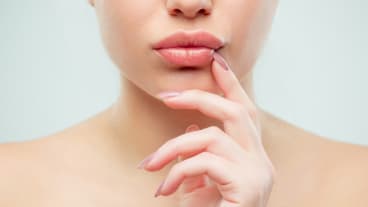 Lip Reduction Surgery
Lip Reduction SurgeryWhy It’s Time To Trade Your Lip Filler For A Lip Lift
When most people think of lip enhancement, they think of fillers. But lip lifts provide a more defined Cupid's bow and crisper edges so you can skip lip liner all together.
Even before Kylie Jenner released her first Lip Kit or filled, unfilled, and refilled her famous pout, Americans have had an obsession with lips. Sometime in the last decade, plumping pouts with filler became almost as common as highlighting hair — just one more thing to add to the beauty maintenance list.
While temporary, hyaluronic acid-based lip fillers like Restylane® are synonymous with a voluptuous (read: Instagram-friendly) smile, they only offer short-term results. So, it should come as no suprise that longer lasting fixes have started to take hold. According to the American Society of Plastic Surgeons, there were nearly 31,000 surgical (i.e. non-injectable) lip augmentations performed in the U.S. in 2018 — a 66 percent increase from 2000 and 4 percent boost from the previous year.
The Rise of Lip Lifts
So, what's behind the surge? The lip lift, a far-from-new but largely under-the-radar surgical procedure is breaking the bee-sting barrier with permanent results that are customizable and appear naturally full with nary a "trout mouth" or "duck lip" in sight. “In-office lip lifts are super hot right now,” says Philadelphia-based board certified facial plastic surgeon Jason Bloom, MD. “Surgeons have really perfected the technique so that lips are actually rolled out and rejuvenated.”
The Procedure
For the uninitiated, the lip surgery raises the edges of the lips (a.k.a the vermilion border), causing the pout to look larger and plusher. “You’re essentially releasing the red part of your top lip that lies underneath, so the upper lip looks fuller and bee-stung,” says Dr. Bloom.
Long coupled with a facelift, stand-alone lip lifts are now a common cosmetic surgery request. Ideal for patients who are (a) tired of the maintenance associated with lip injections or (b) want a more natural-looking result, the 90-minute operation is performed under local anesthesia in a plastic surgeon’s office and can cost anywhere from $2,000 to $6,000.
During the procedure, the surgeon carves a bullhorn-shaped strip of skin below the nostrils to pull up the philtrum (the space between the Cupid's bow and base of the nose). In doing so, the inner part of the upper lip is revealed and the shape and appearance of the pout is enhanced.
“As we decrease the length of the philtrum, the area under the top lip is rolled out and maximized,” says Dr. Bloom. “The larger the wedge of tissue you remove, the more significant the pout, so you are able to customize the effect, and the results are permanent. Your face continues to age, of course, but you don’t need to worry about coming in every six months.”
That personalized fullness is exactly what Jayne, a 41-year-old sales rep, had in mind when she opted for a stand-alone lip lift surgery after seeing her mother have it done as a part of a facelift. “Her lips looked more youthful and fuller — but still like her lips,” she says. “It was a beautiful effect overall.”
The results were just what she hoped for: a youthfully plump pout that completely changed her beauty routine. “They work perfectly with my face and feel great because they’re all mine,” Jayne says of her new lips. “It’s not something I ever achieved with filler. I don’t even use lip liner anymore. I can wear a little bit of gloss and it looks clean and neat and just right.”
Lip Lift Recovery
While the end result is a permanently poutier pout, patience is required during the recovery process. For the first five days post-surgery, Dr. Bloom encourages patients to wear a surgical mask to conceal the significant puffiness (tightness and tension in the lip area is also common) around the mouth. During this time, ice and over-the-counter pain relievers are a girl's best friend.
Around the two-week mark, the swelling is typically reduced and patients can return to regular activities. A bit of concealer may be needed up to six weeks post-op as the incision heals, and it may take six months or more for the mark to fully fade.
"The key to having a good result and avoiding scarring under the nose is meticulous planning and suturing,” Dr. Bloom explains. “Make sure you have a cosmetic surgeon who is well-versed in understanding how the lip functions and where the tension comes from that supports the upper lip.”
Fortunately, even the lengthy recovery couldn't dampen Jayne's enthusiasm for her lip lift results. “There’s no question that the downtime was significant,” she shares. “It was a couple of weeks of just humongous swollen lips, but now I love them.”
Related Procedures

AI Plastic Surgeon™
powered by'Try on' aesthetic procedures and instantly visualize possible results with The AI Plastic Surgeon, our patented 3D aesthetic simulator.
